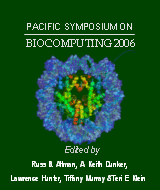Finding Diagnostic Biomarkers in Proteomic Spectra
Pratapa PN, Patz EF Jr, Hartemink AJ
2Duke University Medical Center, Depts. of Radiology & Pharmacology and Cancer Biology, Box 3808, Durham, NC 27710
E-mail:patz0002@mc.duke.edu
Pac Symp Biocomput. 2006;:279-290.

Abstract
In seeking to find diagnostic biomarkers in proteomic spectra, two significant problems arise. First, not only is there noise in the measured intensity at each m/z value, but there is also noise in the measured m/z value itself. Second, the potential for overfitting is severe: it is easy to find features in the spectra that accurately discriminate disease states but have no biological meaning. We address these problems by developing and testing a series of steps for pre-processing proteomic spectra and extracting putatively meaningful features before presentation to feature selection and classification algorithms. These steps include an HMM-based latent spectrum extraction algorithm for fusing the information from multiple replicate spectra obtained from a single tissue sample, a simple algorithm for baseline correction based on a segmented convex hull, a peak identification and quantification algorithm, and a peak registration algorithm to align peaks from multiple tissue samples into common peak registers. We apply these steps to MALDI spectral data collected from normal and tumor lung tissue samples, and then compare the performance of feature selection with FDR followed by classification with an SVM, versus joint feature selection and classification with Bayesian sparse multinomial logistic regression (SMLR). The SMLR approach outperformed FDR+SVM, but both were effective in achieving good diagnostic accuracy with a small number of features. Some of the selected features have previously been investigated as clinical markers for lung cancer diagnosis; some of the remaining features are excellent candidates for further research.
[Full-Text PDF] [PSB Home Page]